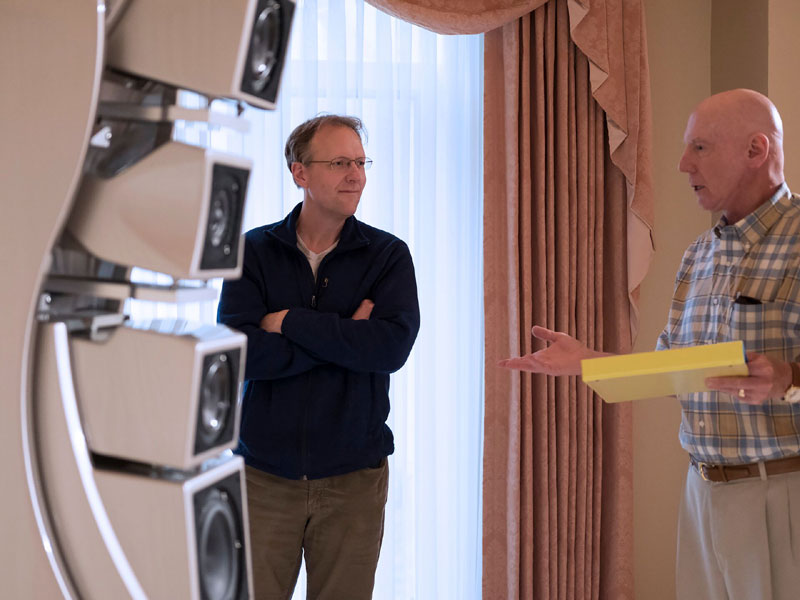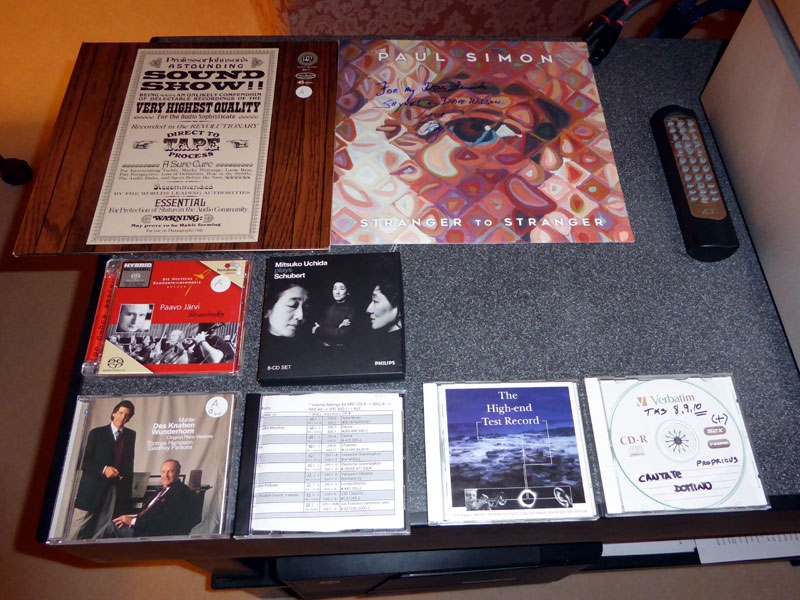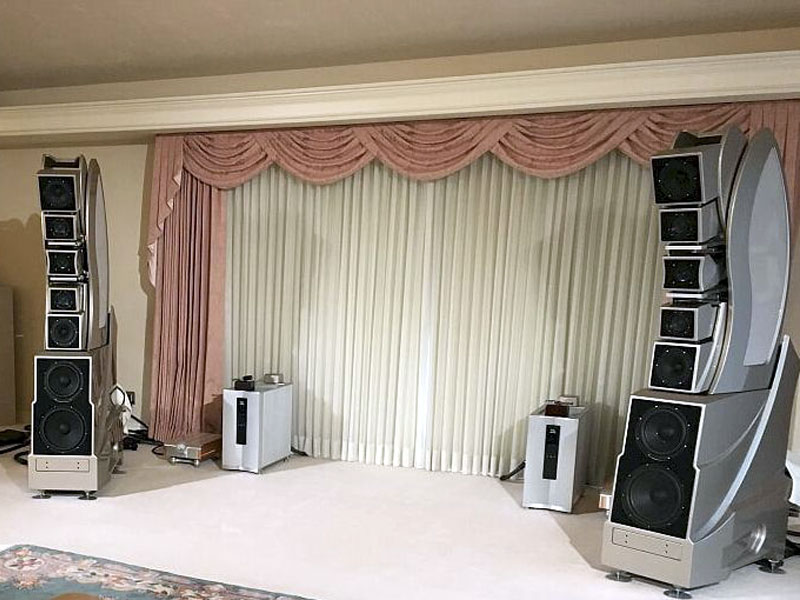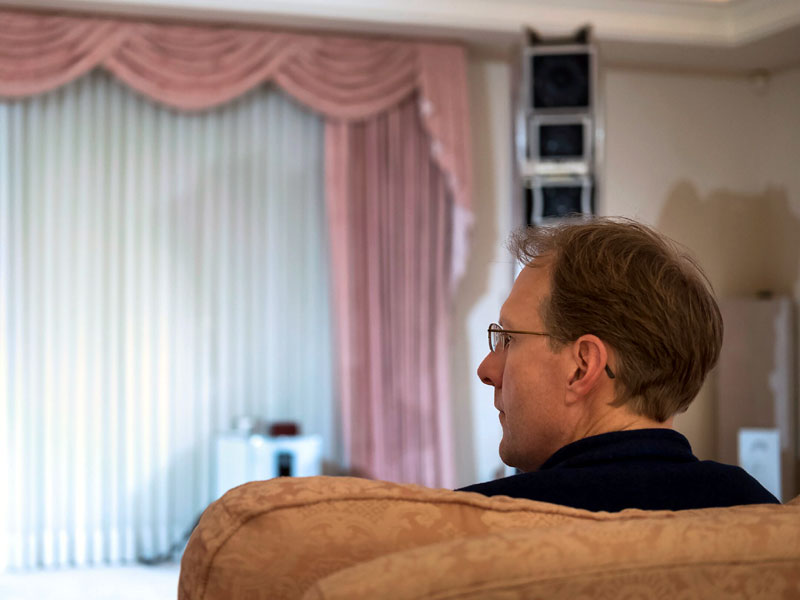Time Further Out: Listening to the Wilson Audio WAMM Master Chronosonic
The design work for the WAMM MC began more than five years ago, and we in the audio press were first alerted to the speaker's existence two years ago at a presentation during CES. It is based on the premise that time-domain performance is at least as important as frequency-domain performance and is even more difficult to perfect. Some of the earliest design work had nothing to do with cabinet materials, crossovers or drivers. David Wilson and his son Daryl (who is Wilson Audio’s new CEO) set about measuring the time lag of amplifiers and speaker cables. The Wilsons discovered that every amplifier and speaker cable has a time signature -- a characteristic spectrum of time delay, which can as high as 80 or 90 milliseconds in a particular region. Thus, the WAMM MC, with its extreme time-domain accuracy, is able to correct the delay in the electronics and cables immediately upstream. For this reason, the Wilsons refer to the WAMM MC as "a tool," a concept that is not new to David Wilson, given that his original WATT was designed as a location monitor, not an audiophile speaker.
The WAMM MC makes a visual statement when you first see it. It's understandable why Wilson Audio forbid photography when the company previewed the speaker at CES. That early prototype only resembles the finished product in cursory fashion, a somewhat crude boxiness being replaced by a sultry, organic presence. I asked David Wilson about the aesthetic choices, and his response echoed a question that so many people would have asked if that prototype had become the finished speaker: "Why does it have to look like a speaker?" In the WAMM MC I see some of the voluptuous curves of a Rousseau jungle scene, mixed with the more subtle geometric lines of other Wilson Audio speakers. Whatever the case may be, this is one very large speaker whose profile bespeaks refinement, "Why does it have to look like a speaker?" indeed. The most radical part of the WAMM MC to design and create had to be the mechanism by which the front-facing upper modules (there are also a rear-facing tweeter and midrange) are adjusted. This superstructure is made of three different materials: Wilson’s existing X and new W materials along with machined aircraft-grade aluminum, which, in the production speakers, will have a finish befitting the metalwork of a fine watch. What’s special -- unique, in fact -- about this piece of the WAMM MC is that it allows infinite fine adjustment of the five upper modules, ensuring what David Wilson said was less than 10 milliseconds of time-domain delay for any combination of listening position, amplifier and speaker cable. The grilles on the side of the speaker hide the entire structure from view, adding to the natural, graceful look.
Some of the recordings. I’ve attended a half-dozen demonstrations in David and Sheryl Lee Wilson’s listening room over the years, and each has been an introduction of the product at hand as well as a discussion of the larger concepts behind it, reinforced with carefully chosen musical examples. With the WAMM MC, the Wilsons began with three examples of classical music whose venues were distinct -- and ones whose sonic fingerprint David Wilson knows well. The WAMM MC resolved not only the music itself but the differences among the venues to a spectacular degree. In fact, it was the capturing of the venues, their unique manners of projecting direct and reflected sound, that was most startling, simply because I’ve not heard a speaker do this as well, and that includes Wilson’s own Alexandria XLF ($210,000/pair) and Alexx ($109,000/pair). It actually took some time to reconcile this aspect of the WAMM MC with essentially every speaker, every complete audio system, I had heard up to that point. I know that this will seem like overstatement, but it’s absolutely what I thought as I sat in silence after each cut ended: What did I just hear? The most provocative music played was a very short passage -- five seconds long to be exact. David Wilson explained that he had become interested in the opening of the Third Movement of Mahler’s Second Symphony, which is a series of five tympani strikes. He realized that he had a number of different performances of the piece, and he decided to rip the opening of the Third Movement from all of them and then burn them onto a CD-R, so they could be played in close succession. He played ten for me, and the results were fascinating. Not only was it simple to make out the difference in tympani, mallets and playing techniques, the placement within the soundstage was vastly different -- sometimes from slightly within the left channel, sometimes nearly (but not exactly) in the center, and sometimes skewed to the right. I am a great believer in such comparative listening, although what I’ve done on my own was play different versions of the same recording, either in digital or analog, and note differences. In this way, I can easily get a sense of how well a system resolves, because what I'm hearing are differences in source material, mastering and format -- essentially how carefully the label has created the recording. With the opening of the Third Movement of Mahler’s Second Symphony, the differences were in the recordings as well as the performances, and the WAMM MC made them plain. The speaker settled to blackness with startling abruptness, and it was balletic in its retrieval of musical detail. The distinct characters of those five tympani strikes, none delivered with extreme force, were as much about the silence and air between them as about the mallet hitting skin.
David Wilson also played a couple of sonic spectaculars, including one I knew well: a cut from the Red Norvo LP The Forward Look [Reference Recordings RR-8]. If you don’t know this recording, in either digital or analog, you should. Keith Johnson was a teenager when he made it; it’s incredibly immediate and a striking reminder that the vibes, which Norvo plays, is definitely a percussion instrument. The venue is closed in, sounding like the basement of a VFW post, which only enhances the transient fireworks. Following this was an unnamed cut I've heard many times in the Wilsons' room and my own: a demo track featuring a bass guitar and drum kit playing together. This has massive transient punch and bass power; I could feel the kick drum hit my chest, then rattle the back of my chair. This wasn't the time delay the WAMM MC was created to eliminate, but it was certainly thrilling. The highlight of my listening was a cut from one of David Wilson’s own classical recordings -- with a twist. Instead of playing the CD, LP or perhaps a high-resolution file, the Wilsons decided to go all out, playing the master tape on their own Studer tape deck. We all can remember various demos whose sound seemed closer to live music than any others. On my list were a couple of previous times in David Wilson’s listening room, a demo in the listening room at Avalon Acoustics, and two or three instances at shows. However, hearing that master tape over the WAMM MC eclipsed them all. The clarity, purity, unforced resolution and insight into the recording were without equal in my experience. This is both good and bad: good, because I now know that the most lifelike sound I've heard can be pinned down to this single demo; bad, because outside David Wilson’s listening room it won’t be re-created. I was the final person to hear this pair of WAMM MCs. After I listened to a few of my own tracks from CD-Rs, Daryl Wilson began tearing down the speakers, which were to be replaced with a pair that Wilson Audio calls the "designer proof." These are the speakers that David Wilson will either approve, and will become the basis for production units, or reject. During disassembly, I was able to see for myself how smoothly the mechanism for aligning the modules works and how intelligently all of the wires feed through to the speaker’s rear panel. The aforementioned rear-facing tweeter and midrange are housed in their own separate module whose clever mounting, six feet from the ground, makes setup quicker and easier. I almost expected a levitation system to emerge from the bottom of the bass cabinet at the push a hidden button.
You will read much more about the WAMM MC
across the Internet, as the Wilsons hosted a number of audio journalists during the past
few weeks, including Roy Gregory and Dennis Davis. A two-hour demo
certainly isn’t comprehensive enough to reveal everything about a product as
ambitious and far-reaching as the WAMM Master Chronosonic (it takes the Wilson factory
over three months to make a pair), but it can reveal new levels of recorded detail and
musical expression in known recordings, if they exist to be discovered, of course.
That’s what I took away from this demo, along with a wish for more listening -- more
time -- at a future date. |




